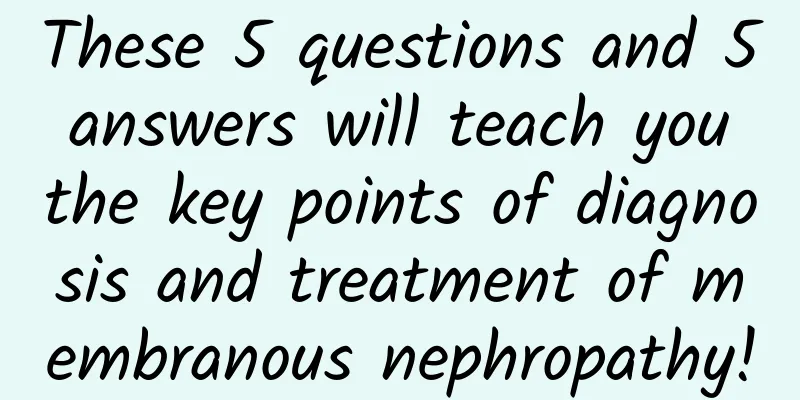These 5 questions and 5 answers will teach you the key points of diagnosis and treatment of membranous nephropathy!

|
Membranous nephropathy is a common pathological cause of adult nephrotic syndrome, but in fact, the causes of membranous nephropathy are diverse, so it is easy to make mistakes in treatment . For this reason, "Yilu Shenkang" has specially compiled 5 questions and 5 answers about membranous nephropathy to help clinicians better understand it. 1. Question: What is membranous nephropathy? Membranous nephropathy is a pathological morphological diagnostic term, referring to a group of diseases in which immune complexes are deposited under the epithelial cells of the visceral layer of the glomerulus, leading to a series of lesions in the glomerular basement membrane. The typical manifestation is diffuse and heterogeneous thickening of the glomerular basement membrane and the formation of "spikes". 20%~25% of membranous nephropathy is secondary to other diseases such as hepatitis B virus or other infections, autoimmune diseases (systemic lupus erythematosus, Sjögren's syndrome, rheumatoid arthritis, etc.), drugs (gold preparations, penicillamine, etc.), tumors, etc. Active treatment of the primary disease or removal of the pathogenic factors can alleviate or even eliminate the symptoms. However, the cause of most membranous nephropathy is not clear . Therefore, according to the etiology of membranous nephropathy, membranous nephropathy is clinically divided into idiopathic membranous nephropathy and secondary membranous nephropathy. Among them, idiopathic membranous nephropathy accounts for 80% of membranous nephropathy, and more than 30% of patients will have persistent proteinuria and develop into end-stage renal disease. Question 2: What are the clinical manifestations of membranous nephropathy? (1) It is more common in people over 40 years old, and the onset is often insidious . (2) Nephrotic syndrome : massive proteinuria, hypoalbuminemia, hyperlipidemia and severe edema. (3) Microscopic hematuria . (4) Some patients have hypertension or renal impairment . (5) Physical signs : Edema of the lower limbs or face. In severe cases, peritoneal effusion and pleural effusion may occur, mostly in the form of transudate. Some patients may have no clinical symptoms, but may be found to have proteinuria during routine physical examinations. It should be noted that if patients with idiopathic membranous nephropathy are not treated in time, one-third of them will develop end-stage renal disease about 10 years after onset, and ultimately can only rely on hemodialysis or kidney transplantation to prolong their lives. Question 3: How to distinguish between secondary membranous nephropathy and idiopathic membranous nephropathy? Secondary membranous nephropathy refers to a disease with a clear cause , which can be seen in rheumatic diseases such as lupus and rheumatoid arthritis, infectious diseases such as hepatitis B virus and Epstein-Barr virus, taking gold preparations, penicillamine, heavy metals and environmental factors, and tumors . Generally, the treatment of the primary disease can alleviate the disease. The cause of idiopathic membranous nephropathy is not very clear at present, and comprehensive treatment is required in combination with renal puncture pathological examination and proteinuria level. Question 4: How is membranous nephropathy diagnosed? Typical renal pathological changes of membranous nephropathy are diffuse thickening of the glomerular basement membrane and the appearance of "spike" changes in the basement membrane. Immunofluorescence tests show that immunoglobulins and complement are deposited along the capillary walls. Diagnosis depends on clinical manifestations and pathological changes in renal biopsy. The pathological changes in renal biopsy are as follows: (1) Optical microscope Lesions of the basement membrane of the glomerular capillary loops are characteristic changes of membranous nephropathy. There are no proliferative and inflammatory exudative lesions in the glomeruli; in the late stage, widening of the mesangial area and segmental cell proliferation may occur; it may also manifest as segmental collapse and abandonment of the glomerular capillary loops, or even destruction of the entire glomerulus. (2) Immunopathology IgG is distributed in granular form along the glomerular capillary loops. Most patients may have C3 deposition, and in a few cases, IgM and IgA deposition may also be seen. (3) Electron microscopy Electron-dense material is deposited on the epithelial side of the basement membrane of the glomerular capillary loop. Stage I: The electron-dense material on the epithelial side is small and scattered, and the basement membrane structure is intact. Stage II, the dense material on the epithelial side increases, the basement membrane-like material proliferates, and it protrudes toward the epithelial side to form spikes. Stage III: The basement membrane-like material further surrounds the electron-dense material into the membrane, the basement membrane is significantly thickened, and irregular stratification occurs. Stage IV: The electron-dense material in the basement membrane begins to be absorbed, electron-lucent areas appear, and the basement membrane shows worm-eaten changes. If electron-dense material is seen in the mesangial area and under the endothelium, attention should be paid to the presence of secondary causes. Question 5: How to treat membranous nephropathy? The treatment of secondary membranous nephropathy is generally based on the primary disease that causes the disease and symptomatic treatment, as well as comprehensive treatment based on the patient's actual clinical condition. Idiopathic membranous nephropathy is mainly treated with angiotensin-converting enzyme inhibitors and angiotensin II receptor antagonists to reduce the patient's proteinuria. At the same time, patients are provided with anticoagulant therapy, lipid-lowering therapy, symptomatic supportive therapy, and hormone combined with immune drug therapy. For patients with refractory conditions caused by hormone absorption disorders, they should be provided with diuretics and albumin supplementation to reduce gastrointestinal edema; for patients with acute renal failure, active kidney treatment is needed to correct reversible factors; for those with substandard hormone and immunosuppressant use, the dosage needs to be adjusted as appropriate based on the patient's symptoms, and the medication should be used strictly according to the doctor's orders and a personalized treatment plan should be adopted. Therapeutic drugs: (1) calcineurin inhibitors, such as cyclosporine, tacrolimus, and mycophenolate mofetil, which have a faster onset of action; (2) multi-target immunosuppressive therapy. In clinical practice, glucocorticoids + mycophenolate mofetil + calcineurin inhibitors are often used for treatment. Different drugs can exert their respective therapeutic effects and achieve a synergistic effect; (3) biological agents such as rituximab monoclonal antibody (mAb) treatment. Text/Editing/Typesetting: Liang Xuhong |
Recommend
How to treat high-risk cervical lesions
Cervical puncture biopsy is a way to check cervic...
Don’t be afraid of cancer anymore. Cancer can be prevented and treated! The key lies in these two points
When it comes to cancer, everyone is "terrif...
Is it normal to have breast tenderness a week before your period?
Women's bodies are in a very special state du...
Can I really use baking soda when I'm pregnant?
Everyone is familiar with baking soda. It is used...
What causes hair loss after giving birth?
After giving birth, the mother's body will un...
Passionate love, sexual etiquette for women in passionate moments
1. Focus during sex During sex, women usually ask...
Why do girls get pelvic inflammatory disease?
Almost 80% of women suffer from pelvic inflammato...
What is the cause of the granulation at the female vaginal opening?
Young people nowadays are more open-minded and of...
What to do if you have severe gastrointestinal reactions in early pregnancy
Many pregnant women experience very strong pregna...
The best gift God has given to women is to control all gynecological diseases
Women's physique is naturally cold. Women who...
Deloitte: Media and Entertainment Industry Outlook 2023
As we head into 2023, there are signs that change...
What causes vaginal ulcers?
Ulcers can occur in many parts of the human body,...
Can you bear the pain of childbirth?
Every mother has experienced the pain of childbir...
Spring is the right time to nourish your liver! Eat the three little fruits that your liver loves most~
Spring brings life, summer brings growth, autumn ...
Early pictures of vulvar flat warts
Flat warts are no stranger to many friends. They ...









